
11-11-2025 20:16
Bohan JiaHi, lastly I have found these tiny yellow decayin

09-11-2025 13:20
Hello.A tiny ascomycete, appearing as erupting gra

08-11-2025 00:29
 Francois Guay
Francois Guay
I found this species in Quebec, Canada, on herbace

04-11-2025 09:07
Hello.A suspected Hymenoscyphus sprouting on a thi

04-11-2025 12:43
 Edvin Johannesen
Edvin Johannesen
Hi! One more found on old Populus tremula log in O
Ijuhya, striate sp., on herbal stem
Viktorie Halasu,
06-06-2021 11:51
 Hello,
Hello, I couldn't find a name for this Ijuhya in the latest 2019 key.
On an unidentified herbal stem ca 5 mm thick. Riparian lowland forest, clearing under a power line with Reynoutria, Helianthus tuberosus and other tall plants.
Perithecium doesn't react in LA, seems to be one-layered only.
"Crown" without hairs, only very short cylindric cells are protruding on places.
Asci 8-spored. Spores straight, frequently also more or less bent to allantoid, only 1-septate, finely longitudinally striate.
Anamorph present.
Soc. Sarcopodium sp.
Thank you for any help.
Viktorie
Christian Lechat,
06-06-2021 17:13

Re : Ijuhya, striate sp., on herbal stem
Hi Viktorie,
Is the ascomatal apex conical or flat? In the first image it looks rather conical, and if so it is not an Ijuhya species. Ijuhya is characterized by ascomata with a flat discoid
apex pierced by a small, faintly prominent papilla and a one-layered
ascomatal wall covered by hyphal elements arising from base, proliferating
over ascomatal surface and becoming fasciculate to form
teeth arranged in a stellate fringe around upper margin.
apex pierced by a small, faintly prominent papilla and a one-layered
ascomatal wall covered by hyphal elements arising from base, proliferating
over ascomatal surface and becoming fasciculate to form
teeth arranged in a stellate fringe around upper margin.
Maybe You should compare this specimen with the genus Lasionectria, whose ascomata have a conical apex. Lasionectria differs from Ijuhya in having hairs arising from the cells of ascomatal wall, not from base. Al known species of Lasionectria have striate ascospores.
Good luck,
Christian

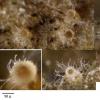
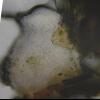
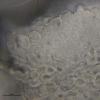
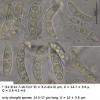
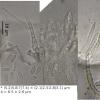
 ornamentation
ornamentation